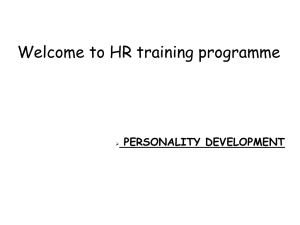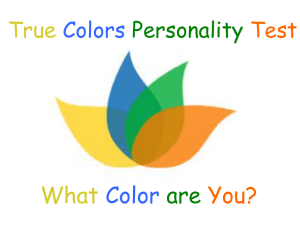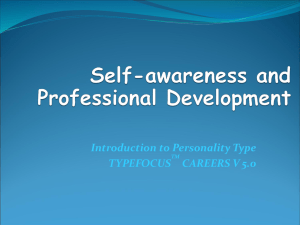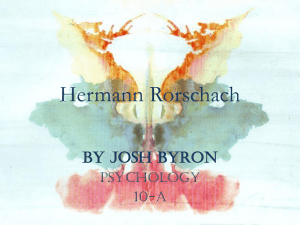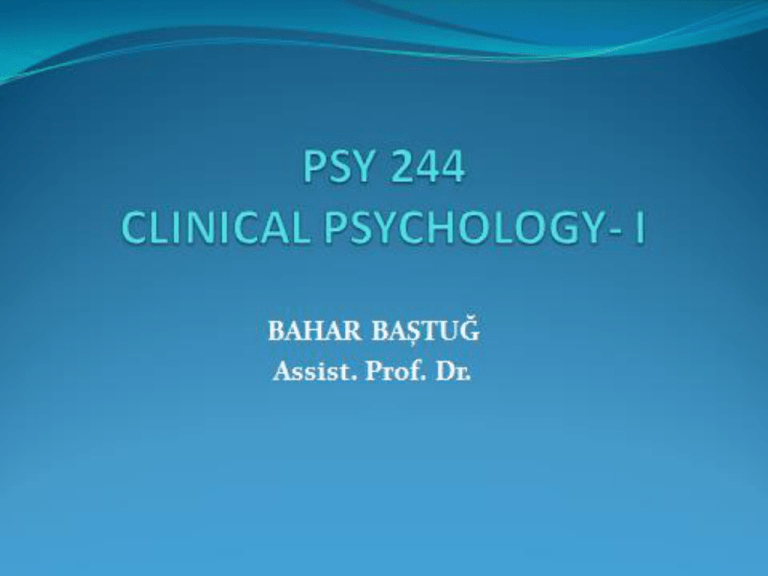
Lecture Preview
Cognitive Testing
Personality Testing
Clinical Inference and Judgment
Communicating Assessment Results
Neuropsychological assessment examines brainbehavior relationships.
Personality testing accesses both underlying
intrapsychic issues and overt behavioral manifestations
of each individual’s unique psyche.
Cognitive Testing
the assessment of a wide range of information
processing or thinking skills and behaviors. They include
general neuropsychological functions involving brainbehavior relationships, general intellectual functions
(such as reasoning and problem solving) as well as more
specific cognitive skills (such as visual and auditory
memory), language skills, pattern recognition, visual
perceptual skills, academic skills, and motor functions.
Cognitive testing
may include
aptitude testing= assesses cognitive potential such as
general intelligence
achievement testing= assesses proficiency in specific
skills such as reading or mathematics.
Cognitive testing refers to many different types of tests
measuring many different types of thinking and learning
skills.
Intelligence Testing
During the beginning of the field, the goals of
intellectual testing were to evaluate children in order to
help them maximize their educational experience and to
assist teachers for children with special needs. It was also
used to screen military recruits.
Now, it is used for vocational planning, assessing learning
disabilities, determining eligibility for gifted and special
education programs, and examining brain-behavior
relationships following head injuries, strokes, or other
medical conditions.
We can learn about an individual’s cognitive strengths
and weaknesses by INT testing. It is used not only to
measure INT but to assess cognitive functioning in
general.
IQ testing has been frequently misused by some
professionals and the public. Argument about the
reliability, validity, meaning, and usefulness of IQ scores
and testing continues today.
What Is Intelligence?
There is no agreement about definition or theory of INT.
Boring (1923)defined INT as what INT tests measure.
Spearman offered a two-factor theory of INT: general
abilities of INT (referred to as g) and specific abilities of
INT (referred to as s).
Thurstone suggested that INT included nine
independent skills or primary mental abilities: verbal
relations, words, perceptual ability, spatial ability,
induction, deduction, numerical ability, arithmetic
reasoning, and memory. These distinct and separate
abilities comprise INT.
Cattell defined fluid abilities as the person’s genetic or
inborn intellectual abilities, crystallized abilities are
what a person learns through experience, culture, and
various opportunities arising from interaction with the
world. Fluid abilities resemble Spearman’s g and refer to
general problem-solving abilities, abstract reasoning,
and ability to integrate and synthesize information
quickly and efficiently. Crystallized abilities resemble
Spearman’s s and refer to specific skills developed by
training and experience.
Piaget added a developmental perspective to intellectual
theory. He suggested that humans have four stages of
cognitive development:
sensorimotor,
preoperational,
concrete operational, and
formal operations
Piaget used the terms
assimilation to refer to gathering information
accommodation to refer to changing existing cognitive
structures (or schemes) to allow for the newly incorporated
and assimilated information.
Contemporary views of INT include practical, creative,
and emotional aspects in addition to more traditional
abstract reasoning and academic abilities. Sternberg
and Gardner accept a more biopsychosocial perspective
in the description of INT.
Sternberg offered a triarchic theory of INT.
Three categories of INT:
componential factor includes analytical thinking,
experiential factor includes creative abilities.
contextual factor refers to good “street smarts”
and the ability to adapt to and manipulate the
environment.
Gardner developed a theory of multiple INTs comprising
six different types of intelligence:
linguistic,
logical-mathematical,
musical,
bodily-kinesthetic,
spatial, and
personal.
Knowing and managing one’s emotions and recognizing
emotions in others are part of emotional INT(EQ) of
Goleman.
However, Sternberg and Gardner’s new views of INT
have not resulted in the development of new tests. The
traditional IQ tests have been used.
How Do Clinical Psychologists Measure
Intelligence?
There are different tests for children, adults, ethnic
minority group members, the gifted, and the disabled.
Some tests are administered individually, others are
administered in groups. Some are easy to administer and
score, others are very difficult to use.
The most popular and frequently used tests are the
Wechsler Scales.The second most frequently used INT
test is the Stanford-Binet (Fifth Edition).
Wechsler Scales for Adults
The Wechsler- Bellevue INT Scale was developed in 1939.
The Wechsler Adult INT Scale (WAIS) in 1955
The Wechsler Adult INT Scale-Revised (WAIS-R)in 1981 in WAIS-III in 1997
WAIS-IV in 2008
The WAIS-IV consists of:
4 verbal subtests: Information, Similarities, Vocabulary and Comprehension,
5 perceptual reasoning subtests: Picture Completion, Block Design, Matrix
Reasoning, Visual Puzzles and Figure Weights.
3 working memory subtests: Arithmetic, Digit Span, Letter-Numbering
Sequencing
3 processing speed subtests: Symbol Search, Coding and Cancellation.
Wechsler Scales
The WAIS-IV generally takes about one to one-and-ahalf hours to individually administer to someone
between the ages of 16 and 74.
Four IQ scores are determined using the WAIS-IV:
Verbal Comprehension Index Score
Perceptual Reasoning Index Score
Working Memory Index Score
Processing Speed Index Score +++++
Full Scale IQ score
Wechsler Scales
The mean IQ score is 100 with a SD of 15.
Scores between 90 and 110 the average range of
intellectual functioning.
Scores below 70 are considered to be in the mentally
deficient (MR) range,
Scores above 130 are considered to be in the very superior
range.
Wechsler Scales
Kaplan have developed WAIS-R as a Neuropsychological
Instrument (WAIS-R NI) with additional subtests
(Sentence Arrangement, Spatial Span, Symbol Copy) as
well as modifications for administration and scoring in
order to measure individuals who have brain
dysfunction.
We can make inferences about cognitive strengths and
weaknesses by examining the pattern of scores obtained
on each WAIS-IV subtest.
Wechsler Scales
High scores on the vocabulary subtest relative to very
low scores on the block design subject might suggest
that the person has good use of language in solving
problems and a poorer ability to solve problems using
perceptual and motor integration skills.
We can learn about neuropsychological problems such
as brain damage. For example, low scores on
performance subtests of the WAIS-IV relative to high
scores on the verbal subtests has been associated with
alcoholism and dementia.
Wechsler Scales For Children
The Wechsler INT Scale for Children (WISC) in 1949
The Wechsler INT Scale for Children- Revised (WISC-R)
in 1974
The Wechsler INT Scale for Children-Third Edition
(WISC-III) in 1991
The Wechsler Intelligence Scale for Children-Fourth
Edition (WISC-IV) in 2003. The WISC-IV was developed
for children aged 6 to 16.
Wechsler Scales For Children
four categories:
Verbal Comprehension: Similarities, Vocabulary, and
Comprehension
Perceptual Reasoning: Block Design, Picture Concepts,
and MatrixReasoning
Working Memory: Digit Span,Letter-Number Sequencing
Processing Speed: Coding, Symbol Search
Wechsler Scales For Children
The WISC-IV provides four index score IQs +++++++
a full-scale IQ score.
These IQ scores all are set with a mean of 100 and a
standard deviation of 15. Subtest scores have a mean of
10 and a standard deviation of 3.
The Wechsler Preschool and Primary
Scale of INT (WPPSI)
The WPPSI in 1967
the WPPSI-R in 1989
the WPPSI-III in 2002, the current version
The WPPSI-III is used for children ranging in age from 2 to 7.
four IQ scores:
Verbal IQ: Information, Vocabulary, and Word Reasoning
Performance IQ: Block Design, Matrix Reasoning, and Picture Concept
Processing Speed IQ: Symbol Search and Coding Subtest
+++++
Full Scale IQ.
IQ scores have a mean of 100 and a standard deviation of 15, while the
subtest scores have a mean of 10 and a standard deviation of 3.
Stanford-Binet Scales
The first standardized INT test, developed by Alfred Binet in
1905.
The test has been revised many times and most recently, in
2003.
It can be used with individuals from 2 years of age through
adulthood.
It consists of Nonverbal (NV) and Verbal (V) domains +++++
a full-scale IQ score.
The age of the subject determines which subtests are used in
any evaluation.
IQ scores are based on a mean of 100 and a standard deviation
of 15.
Stanford-Binet Scales
five areas:
Fluid Reasoning (FR): Object Series/Matrices, Early
Reasoning, Verbal Absurdities, and Verbal Analogies
Knowledge (KN): Vocabulary, Procedural Knowledge,
and Picture Absurdities
Visual-Spatial processing (VS): Form Board, Form
Patterns, Position and Direction
Working Memory (WM): Block Span, Memory for
Sentences, and Last Word
Quantitative Reasoning (QR): Quantitative Reasoning
Other Tests of Intellectual Ability
Other tests are available for specific populations such as
gifted children, hearing impaired individuals, or with
minority group members.
Kaufman Tests (Kaufman Assessment Battery for Children
[K-ABC-II]
Peabody Picture Vocabulary Test- Revised,
Woodcock-Johnson Psychoeducational Battery,
Raven’s Progressive Matrices,
General Ability Measure for Adults,
System of Multicultural Pluralistic Assessment (SOMPA)
Neuropsychological Testing
Other tests focus on brain-behavior relationships and
neuropsychological functioning. Brain impairment is
due to head injury, substance abuse, stroke, or other
illnesses and injuries. Brain impairment impacts the
cognitive ability to use language, think and make
appropriate judgments, perceive and respond to stimuli,
and remember old or new information.
Neuropsychological testing assesses intellectual,
abstract reasoning, memory, visual-perceptual,
attention, concentration, gross and fine motor, and
language functioning.
Neuropsychological Testing
Neuropsychological test batteries:
The Halstead-Reitan Battery and the Luria- Nebraska
Battery are the most commonly used. The HalsteadReitan Battery can be administered to persons aged 15
through adulthood and consists of 12 separate tests,
the MMPI-2 and the WAIS-III. It takes 6 to 8 hours to
administer.
The Luria-Nebraska Battery consists of 11 subtests
which assess reading, writing, speech, memory,
arithmetic, and other skills. It takes about 2.5 hours to
administer.
Bilnot Battery, Prof. Dr. Sirel Karakaş
Neuropsychological Testing
Another neuropsychological testing approach, the
Boston Process uses a subset of a wide variety of tests in
order to answer specific neuropsychological questions.
Performance on one test determines which tests or
subtests will be used next. The testing process could be
short or long involving few or many tests.
Individual neuropsychological tests:
the Wechsler Memory Scale-III , the Benton Visual
Retention Test, the WAIS-R as a Neuropsychological
Instrument and Wisconsin Card Sorting Test.
Neuropsychological Testing
Physiological tests such as evoked potentials,
electroencephalography (EEG), and reaction time measures may
be useful in the assessment of INT and cognitive abilities.
Evoked potentials assess the brain’s ability to process the
perception of a stimulus.
EEG measures electrical activity of the brain.
We are currently not licensed to administer neuroimaging
techniques such as computerized axial tomography (CAT),
magnetic resonance imaging (MRI), and positron emission
tomography (PET), these techniques investigate brain structure
and function.
In the SCH, AD, anorexia nervosa, alcoholism, and
mood disorders, cortical atrophy or actual loss of brain
tissue has occured.
Neuropsychological tests are used with clinical
interviews, behavioral observations, and other cognitive,
personality, and physiological assessment tools.
Neuropsychological testing is not isolated from other
evaluation techniques. Neuropsychologists must have a
high level of information about brain structure and
functioning.
Questions on IQ and Cognitive Testing
ARE WE BORN WITH A CERTAIN IQ?
For some people, we are born with an innately determined
level of IQ that is not influenced by social, emotional, and
environmental factors. For some, there are some IQ
differences among different racial groups. The book, The Bell
Curve (Herrnstein & Murray, 1994) suggested African
Americans <Caucasians <Asians less intelligent.
Heritability of INT is between .40 and .80.
biological (e.g., prenatal care, genetics, nutrition),
psychological (e.g., anxiety, motivation, self-esteem), and
social (e.g., culture, SES) factors are associated with INT.
Questions on IQ and Cognitive Testing
ARE IQ SCORES STABLE OVER TIME?
Many factors influence the stability of IQ scores.
1. Scores obtained when a child is very young are likely
to be less stable than scores obtained when a child is older.
Early childhood tests focus on perceptual and motor skills,
tests for older children and adults focus more on verbal skills.
2. The longer the time between testing administrations,
the more unstable the IQ score will appear.
3. Environmental factors such as stress, nutrition,
educational opportunities, exposure to toxins such as lead,
and illness play a role in the IQ scores.
Questions on IQ and Cognitive Testing
ARE IQ SCORES BIASED?
Do children from high SES perform better on IQ tests than
those from lower SES?
IQ tests may not be appropriate for ethnic minority groups.
Most standardized IQ tests such as the Wechsler and
Stanford-Binet scales are not biased. But, tests can be
misused by both unqualified and well-meaning people.
Questions on IQ and Cognitive Testing
Flynn effect
IQ scores have increased over generations, by about 3
points every 10 years. This is due to influences such as
better education, improved nutrition, technological
advances, and nuclear family.
Questions on IQ and Cognitive Testing
SHOULD THE TERMS INTELLIGENCE QUOTIENT
OR IQ CONTINUE TO BE USED?
Some experts suggest that general IQ scores must be left
out. Some new tests such as the newest version of the
Stanford-Binet have not used the terms intelligence
quotient or IQ.
Conclusion
Cognitive testing is used
to identify overall intellectual skills,
to identify cognitive strengths and weaknesses,
to assess the presence of learning disabilities,
to predict academic success,
to examine brain dysfunction, and
to assess personality.
We must be cautious in the use of cognitive testing.
We must be aware of the limitations of the testing
situation and the test.
We must be careful to use tests for the purpose for which
the test was developed.
We must understand the biopsychosocial influences
that might affect the scores. Stress level and coping
abilities are associated with cognitive abilities.
Personality testing
strives to observe and describe the structure and content
of personality. Personality can be defined as the
characteristic ways in which an individual thinks, feels,
and behaves.
Personality testing is useful in clarifying
diagnosis,
problematic patterns and symptoms,
intrapsychic and interpersonal dynamics, and
treatment implications.
What Are Personality and
Psychological Functioning?
Each individual has a unique manner of interacting with
the world. Personality is the enduring styles of thinking
and behaving when interacting with the world.
Personality is influenced by biological, psychological,
and social factors. Between 20% and 60% of the variance
in personality traits are influenced by genetic factors,
remaining is influenced by psychosocial factors (e.g.,
relationships with parents, siblings, and friends, as well
as life events).
Psychological functioning
is a more general term. It refers to the individual’s cognitive,
personality, and emotional worlds. Psychological functioning
includes personality as well as other aspects of emotional,
behavioral, cognitive, and interpersonal functioning. But, we
mean to psychological functioning as noncognitive areas of
functioning such as mood and interpersonal relationships.
While anxiety, depr, and anger may be persistent personality
traits, they can also be temporary mood states. Someone facing
stressful life events, such as the death of a loved one, may
experience severe anxiety, depr, or anger. The individual may feel
and behave in an anxious or depressed manner as a reaction to
the stressful event(s) but does not tend to be anxious or
depressed most of the time.
Is Personality Really Persistent?
Many people believe that behavior is consistent across
situations, many argue that behavior is generally
situation specific.
Behavior is predictable but is not rigidly consistent.
People have personality styles that are generally
consistent but interact with situational factors;
personality and behavior differs from situation to
situation.
How to Measure Personality and Psychological
Functioning?
Interviews, observations, checklists, inventories, and even
biological assessments ++++++ tests for personality and
psychological functioning.
These tests can be classified as either objective or projective.
Objective testing presents specific questions (e.g., Do you
feel sad more days than not?) or statements (e.g., I feel
rested) and the person responds by using specific answers
(e.g., yes/no, true/false, multiple choice) or a rating scale
(e.g., 1 = strongly disagree, 10 = strongly agree).Then scores
are compared with those of reference groups, using norms.
Projective testing uses ambiguous or unstructured stimuli
such as inkblots, incomplete sentences, or pictures of
people engaged in various activities. Subjects are asked to
respond freely to the stimuli, rather than answering specific
questions using specific structured responses (e.g., yes/no,
true/false, agree/disagree).
tell stories about pictures,
describe what you see in an inkblot, or
say the first thing that comes to your mind when hearing
a word
Objective Testing
There are hundreds of objective tests. The most commonly
used one is the Minnesota Multiphasic Personality
Inventory (MMPI), now in its second edition (MMPI-2).
Adolescent version is called the MMPI-Adolescents
(MMPI-A).
Other objective tests such as the Millon Clinical Multiaxial
Inventory-III (MCMI-III), the 16 Personality ±Factors
Questionnaire, Fifth Edition (16PF), and the NEOPersonality Inventory-Revised (NEO-PI-R).
THE MINNESOTA MULTIPHASIC PERSONALITY
INVENTORY
The MMPI was published in 1943 by psychologist S.
Hathaway and psychiatrist J. C. McKinley.
The MMPI was revised and became available as the MMPI2 in 1989. The original MMPI consisted of 550 true/false
items. The items were selected from other personality tests
and from the developers’ clinical experience. The MMPI is
used with individuals ages 16 through adulthood.
The MMPI takes about one to one-and-a-half hours to
complete.
MMPI
The MMPI gives us four validity scores and ten clinical
scores. The validity measures include the
? (Cannot Say),
L (Lie),
F (Validity), and
K (Correction) scales.
MMPI
Admitting to many
problems or “faking bad” is
reflected in an reverse V
configuration with low
scores on the L and K
scales and a high score on
the F scale.
L
F
K
MMPI
Presenting oneself in a
favorable light or “faking good”
is reflected in a V configuration
with high scores on the L and K
scales and a low score on the F
scale.
L
F
K
The clinical scales: Hypochondriasis (Hs), Depression
(D), Hysteria (Hy), Psychopathic deviation (Pd),
Masculinity-femininity (Mf), Paranoia (Pa),
Psychasthenia (Pt), Schizophrenia (Sc), Hypomania
(Ma), and Social Introversion (Si).
Scores are normed using standardized T-scores. T scores
means that each scale has a mean of 50 and a SD of 10.
MMPI
Since the MMPI was published, a number of additional
subscales have been developed. It has been estimated
that there are over 400 subtests of the MMPI. Although
the original MMPI was the most widely used test, a
revision was needed.
1.The original sample included Caucasians living near
University of Minnesota hospitals. For this reason,
MMPI did not use a representative sample.
2. More complicated methods of test construction and
analysis of today were not available in the 1930s.
MMPI-2
During the late 1980s, MMPI was restandardized and many of
the items were rewritten. Many new items were added, and
outdated items were excluded. The MMPI-2 (Butcher, et all.
1989) consists of 567 items and can be used with individuals
aged 18 through adulthood.
The MMPI-2 uses the same validity and clinical scale names
as the MMPI.
The Minnesota Multiphasic Personality
Inventory-Adolescent (MMPI-A)
was developed for use with teens between the ages of 14
and 18 by Butcher, et al. in 1992. The MMPI-A has 478
true/false items and includes a number of validity
measures in addition to those available in the MMPI.
THE MILLON CLINICAL MULTIAXIAL
INVENTORIES
include several tests that assess personality functioning using the
DSM-IV and the Theodore Millon theory of personality.
The Millon was designed to assess personality disorders in the
DSM such as histrionic, borderline, paranoid, and obsessive
compulsive personalities.
The first Millon test was published in 1982; additional tests and
revisions developed during the 1980s and 1990s.
The current version is the MCM-IIII developed by Millon, Millon,
& Davis in 1994. It is a 175 true/false item for persons ages 18
through adulthood and takes a 30 minutes to complete. It
includes 14 personality pattern scales and 10 clinical syndrome
scales.
THE SIXTEEN PERSONALITY FACTORS
(16PF)
was developed by Raymond Cattell in 1993. It is currently
in its fifth edition.
It is a 185-item multiple-choice questionnaire that takes
approximately 45 minutes to complete.
The 16PF is administered to individuals ages 16 years
through adulthood.
Scoring the 16PF results in 16 primary personality traits
(e.g., warmth, reasoning , dominance, sensitivity,
openness to change, self seliance, perfectionism and
tension) and five global factors (e.g., anxiety,
extraversion).
THE NEO-PERSONALITY INVENTORY
REVISED (NEO-PI-R):
was developed by Costa & McCrae in 1985. It is a 240item questionnaire that uses a 5-point rating system.
The NEO-PI-R measures the big five personality
dimensions: neuroticism, extroversion, openness,
agreeableness, and conscientiousness.
Other Objective Tests
Eysenck Personality Questionnaire (Eysenck & Eysenck,
1975) measures three basic personality characteristics:
psychoticism,
introversion-extroversion, and
emotionality- stability.
Projective Testing
The theory behind projective testing is that unconscious
or conscious needs, interests, dynamics, and motivations
are projected onto the ambiguous stimuli, thereby
revealing the internal dynamics or personality.
There are many projective instruments.
the Rorschach,
the Thematic Apperception Test (TAT),
Projective Drawings, and
Incomplete Sentences.
THE RORSCHACH
is the famous inkblot test developed by Hermann Rorschach
in 1921.
The idea of seeing objects in inkblots came from a common
game in the 1800s called Blotto. Someone would put a drop of
ink on a piece of paper and fold the paper in half, creating a
unique inkblot. Others would take turns identifying objects
in the inkblots. Alfred Binet used this technique with
children. Swiss psychiatrist Rorschach noticed that mental
patients respond very differently to this game relative to
others.
The Rorschach consists of 10 inkblots that are symmetrical.
THE RORSCHACH
Half of the cards are black, white, and gray, and half are
colorful.
There are several different ways to administer and score,
the majority of psychologists use the Exner’s method.
During the free-association phase, the question, “What
might this be?” The psychologist writes down everything
the patient says and does not question the patient.
After all 10 cards are administered, the psychologist shows
the patient each card a second time and asks questions.
Inquiry phase, the psychologist might say:
“I want you to help me see what you saw. I’m going to
read what you said, and then I want you to show me
where on the blot you saw it and what there is there that
makes it look like that, so that I can see it too. I’d like to
see it just like you did, so help me now.”
THE RORSCHACH
We ask a question:
“What about the card made it look like a____to you?”
several categories to score:
location (i.e., the area of the blot being used),
content (i.e., the nature of the object being described),
determinants (i.e., form, color, shading, and
movement), and
populars (i.e., the responses typically seen by others).
Scoring of Rorschach
can be very complicated and may take a long time to
complete. Many experienced psychologists do not score
the test in fine detail.
Rorschach responses are associated with psychological
functioning. The use of human movement are associated
with adaptive psychological functioning. Numerous
responses of minor details reflect obsessive-compulsive
traits. Frequent use of the white space is associated with
negativizm and/or avoidance.
Rorschach Interpretation
Human movement – generally positive
Color – emotion
Texture – dependency needs
Many have argued: «the Rorschach is not a reliable and
valid instrument». In fact many graduate programs have
stopped using it.
Exner has developed a method with scoring criteria and
has used this method to demonstrate its’ reliability and
validity.
In a review of Rorschach research, revealed reliability
coefficients were found to be in the .80s and the average
validity coefficient to be about .42.
THE THEMATIC APPERCEPTION TEST
(TAT)
was developed during the late 1930s by Henry Murray
and Christiana Morgan at Harvard University. The TAT
was designed to measure personality factors in research
settings.
The TAT consists of 31 pictures (one of which is blank).
Some of the pictures are designed to be administered to
males, some to females, and others to both genders.
«I will give you a series of pictures and request to tell a
story about each.»
They should reflect what the people in the picture are
thinking, feeling, and doing at that moment, what
happened in the past and what will happen in the future.
After each card is presented to the patient, the
psychologist writes down everything that is said.
For scoring, most clinicians use their clinical experience
and judgment.
The Children’s Apperception Test (CAT)
was developed by Bellak in
1986, for very young
children and describes
animals interacting in
various ways.
PROJECTIVE DRAWINGS
Many clinicians ask both children and adults to draw
pictures to assess their psychological functioning.
People are asked to draw
a house,
a tree,
a person, and
their family doing something together.
the Draw-a-Person test,
the House-Tree-Person Technique, and
the Kinetic Family Drawing Technique.
PROJECTIVE DRAWINGS
on the Draw-a- Person test
instructs the patient to draw
persons of the same and
opposite sex.
PROJECTIVE DRAWINGS
Many clinicians feel that these techniques are quick and
easy methods to establish rapport with children or with
those who have great difficulty expressing their feelings
verbally.
But, some clinicians overinterpret projective drawings
without adequate research support to justify their
interpretations.
SENTENCE COMPLETION TECHNIQUES
There are many different versions:
Beier Sentence Completion Test
Rotter Sentence Completion Test
Items are such as, “Most mothers are _______.”
The patient is asked to give the first response what comes
to mind.
Several scoring systems have been developed. However,
most clinicians prefer to use their own experience and
clinical judgment to interpret the themes that emerge
from the completed sentences.
Questions on
Personality and Psychological Testing
ARE PERSONALITY RESULTS ASSESSED THROUGH
TESTING STABLE?
Many psychologists have assumed that personality is a stable
phenomenon—that each individual’s personality traits and style
are consistent over time and various situations.
But, several researchers have demonstrated that personality is
not stable, depends on specific environmental and situational
circumstances. Rather than thinking of someone as an anxious
person, it is useful to evaluate and understand in which
circumstances he or she is likely to show anxiety (e.g., testing
situations, speaking public, asking someone for a date).
Questions on
Personality and Psychological Testing
ARE PROJECTIVE TECHNIQUES RELIABLE AND
VALID?
Many reviews have concluded: projective techniques
haven’t adequate reliability and validity. Some defender
stated that projective tests are similar to structured
interviews, whose purpose is to better know,
understand, and describe a person.
Most of the debate has centered around the Rorschach.
However, more recent studies have been much more
favorable of the Rorschach if “properly used by trained
clinicians».
TAT and projective drawing techniques have generally failed
to provide research support for their reliability and validity.
Many clinicians report that these instruments are useful for a
better understanding of the patient.
However, the percentage of clinical psychologists who use
projective testing had decreased from about 72% in 1986 to
39% in 2003.
Questions on
Personality and Psychological Testing
ARE PERSONALITY AND PSYCHOLOGICAL
TESTS APPROPRIATE FOR USE WITH
MINORITY GROUP MEMBERS?
We must be aware of the limitations of the tests that we
use and be sensitive to diversity issues when making
judgments based on psychological tests used with
minority groups.
SHOULD PERSONALITY AND PSYCHOLOGICAL TESTS
BE USED FOR EMPLOYMENT DECISIONS?
Many people use personality tests such as MMPI to screen
job applicants for psychiatric disorders or personality
problems.
A shy and withdrawn person may not succeed as a
salesperson; someone who is not detail-oriented may not
succeed as an accountant.
Some have argued that personality tests were not designed
and validated for use in employment settings and should
not be used for employment decisions. Some claim that
personality measures can be used in employment settings.
There are specialized tests for personnel selection.
Clinical Conclusion and Judgment
When we complete an interview, conduct a behavioral
observation, and administer intellectual and personality
testing, we must pull all the information together and make
decisions regarding diagnosis and treatment. Integrating
similar and different information from different sources
requires skill, training, and experience.
We use our own judgment, impressions, and experience
along with objective data to make decisions.The quality of
our clinical judgment can be enhanced by the use of
multiple assessment sources (e.g., interview, case history,
tests, observations).
If a patient reports feeling depressed, if the results of
tests point to depr, we will accurately conclude that the
patient is indeed depressed. Sometimes, clinical
decisions are not so clear. A patient may report feeling
depressed, but scores on tests measuring depr are not
elevated. Or, a patient may deny feeling depressed
during the interview, while testing scores indicate depr.
Depression may be associated with numerous factors:
to have medical conditions (cardiac problems,
diabetes)
to have personality disorders (antisocial, borderline)
to have ADHD, learning disabilities, and other
syndromes
to get medical attention (Munchausen’s syndrome)
to obtain secondary gain (obtain sympathy and
attention from loved ones, staying home from work)
to express their feelings through somatic complaints
and do not recognize their depr.
factors in the environment may lead to depr (loss of
job or a loved one).
We must examine all the pieces of the puzzle. Our
theoretical framework, prior experience and clinical
training become part of clinical judgment.
Assessment is on a regular basis rather than in a single
snapshot at the beginning of treatment. Initial
formulations are constantly being checked and changed
due to the new information.
Psychologists will likely be required to make clinical
judgments that are based on training, experience, and
intuition. Efforts to increase their skills and achieve
reliable, valid, and useful conclusions are worthy
attempts.
Communicating Assessment Results
After testing is completed, analyzed, and interpreted, the
results are communicated to patients and other interested
parties. Results are communicated to others only with the
permission of the person. If the patient is seriously disabled,
permission isn’t necessary.
After a psychological evaluation, the psychologist will
organize a feedback session to show the results to the patient,
explain the findings in understandable language, and answer
all questions. We must explain the assessment results to
other interested parties such as parents, teachers, attorneys,
and physicians.
In addition to oral feedback, we prepare a written report.
A testing report includes the reason for the referral of the
referring party, the list of assessment instruments used,
test scores, the psychologist’s interpretation of the
findings, a diagnostic impression, and recommendations.
The language of report may be very different from one to a
school teacher or a parent or another mental health
professional. We avoid professional jargon, so our reports
will be understandable. Confidentiality is another
important issue when sending them only to interested
part.
Who is competent to administer tests?
Many people administer tests. Learning specialists, social
workers, doctors, marriage and family therapists, and speech
and language therapists may use psychological tests.
There are thousands of tests available for use. It is unrealistic
to expect that psychologists will be competent in all of tests.
Many tests are regularly updated, it is unlikely to expect that
psychologists can keep on top of the latest revisions.
Someone who specializes in the test to adults may be
untrained and unqualified to administer tests to children.
How can we determine who is qualified to use these
tests?
The APA states that testers should have coursework and
competence that cover classical test theory, descriptive
statistics, reliability and measurement error, validity and the
meaning of test scores, normative interpretation of test
scores, selection for appropriate tests, test administration
procedures, issues related to ethnic, racial, cultural, gender,
age, linguistic, and disability variables. They should have
adequate supervision and experience.






